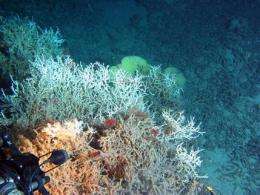In this undated photo provided by arthowardphotography.com, a deep sea coral reef is seen from a four-man submersible more than 1,000 feet down in the Atlantic Ocean about 50 miles off the southeastern coast of the United States. An international conference gets under way Monday Oct. 18, 2010, in Japan that aims to preserve the diversity of plants and animals in the face of pollution, habitat loss and overexploitation of resources. (AP Photo/arthowardphotography.com)
(AP) -- An international conference aimed at preserving the planet's diversity of plants and animals in the face of pollution and habitat loss begins Monday in Japan, facing some of the same divisions between rich and poor nations that have stalled U.N. climate talks.
Seventeen years after the U.N. Convention on Biological Diversity was enacted, it has yet to achieve any major initiative to slow the alarming rate of species extinction and loss of ecosystems despite global goals set in 2002 to make major improvement by this year.
Frogs and other amphibians are most at risk of disappearing, coral reefs are the species deteriorating most rapidly and nearly a quarter of all plant species are threatened, according to the convention, which is convening the two-week meeting.
A key task facing delegates will be to hammer out a set of 20 strategic goals for the next decade.
Unless steps are taken to reverse the loss of Earth's biodiversity, scientists warn that the rate of extinction will climb and natural habitats will be degraded or destroyed - contributing to climate change and threatening agricultural production, fish stocks in the oceans and access to clean water.
Scientists estimate that the Earth is losing species 100 to 1,000 times the historical average, upsetting the intricately interconnected natural world. Prominent insect biologist E.O. Wilson at Harvard University argues that a man-made environmental crisis is pushing the Earth toward its sixth big extinction phase, the greatest since the dinosaurs were wiped out 65 million years ago.
However, some battle lines have already formed between developed and developing nations over the convention's strategic mission statement - whether to take action to halt or simply slow the loss of biodiversity by 2020 - and finding a way to equitably share the benefits of genetic resources, such as plants native to poor countries that have been converted into lucrative drug products in the West.
The convention, which will bring together 8,000 delegates from 193 member nations in Nagoya, 170 miles (270 kilometers) west of Tokyo, was born out of the 1992 Earth Summit in Rio de Janeiro. So far, the convention has failed to meet a series of goals set eight years ago to preserve the world's biodiversity against overfishing, deforestation and pollution.
Conservation groups attribute part of that to a lack of political will and funding. They also say that some of the goals until now have been fuzzy, and partly blame their own failure to make a convincing case that action is needed - something they hope to change in Nagoya.
"We haven't been able to successfully get across a message that our society and economies ultimately depend on this biodiversity," said Bill Jackson, deputy director-general of the International Union for Conservation of Nature. "We have to fix the problem within the next 10 years."
Host country Japan, meanwhile, will be looking to this conference as a chance to portray itself as a protector of biodiversity after helping kill off many of the measures at the CITES, or Convention on International Trade in Endangered Species, meeting earlier this year that would have limited the trade in tuna, sharks and other marine species.
Divisions between rich and poor nations over how to fairly share in the access and benefits of genetic resources could undermine the gathering, observers say.
For example, the rosy periwinkle, a plant native to Madagascar, produces two cancer-fighting substances. Drug companies have grown the plants and profited from them, but little of the money has returned to Madagascar. Developing countries argue they should receive royalties or a share of the benefits of such natural resources.
The convention aims to address this problem by setting up a legal framework by which producers and users can negotiate to reach mutually agreeable terms to ensure equitable sharing of resources and their benefits.
"Developing countries are putting pressure on developed countries and saying if we don't reach an agreement on this issue, we won't give you what you want on the strategic plan," said Patricia Yakabe Malentaqui, international media manager at the environmental group Conservation International. "All the parties are at risk of polarizing the debate."
Another contentious goal will be setting a percentage of the Earth's land and oceans that should be protected by 2020.
Currently, 13 percent of land and less than 1 percent of open ocean is protected - which can range from a strict nature reserve to an area managed for sustainable use of natural resources. Those percentages need to be raised to 25 percent and 15 percent respectively, Conservation International says.
But even if delegates manage to agree to such targets, carrying them out in real life is another matter. Businesses will likely oppose any limits on their activities and population growth means setting aside such protected areas will become increasingly difficult. Furthermore, the U.N. Convention on Biological Diversity has no mechanism for enforcing compliance.
Environmental groups argue that creating protected areas reap huge economic rewards. For example, there is plenty of evidence, says IUCN's Jackson, that providing safe havens for fisheries help their populations recover and flourish.
©2010 The Associated Press. All rights reserved. This material may not be published, broadcast, rewritten or redistributed.






















